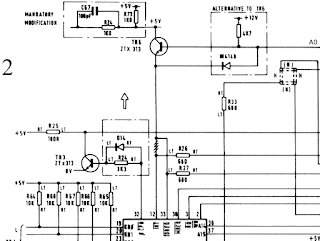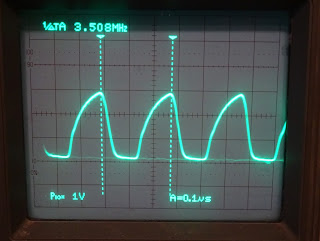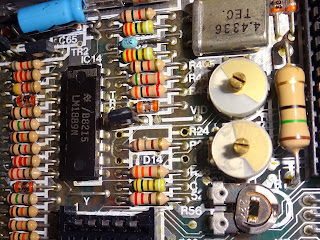This is an old post, preserved for reference.
The products and services mentioned within are no longer available.
Following testing on the issue 1 boards, I have added an extra chip to improve the composite video output. These is now also a reset switch on board, and the list of the extra ZX80 commands that is on the ZX80 case is duplicated on the silkscreen.
The board now has an edge connector and jumpers to select up to 8 ROM images if a 27C512 EPROM is used. The edge connector is the same as the ZX80, but adds ROMCS like the ZX81, driven via a resistor so it can be overridden by an external device.
The power input now has provision for a 7805 regulator mounted ZX81 style with heatsink, or a switch mode 7805 replacement. Power in is via a 2.1mm DC jack, with jumper selectable centre negative (ZX Spectrum, Commodore 16) or centre positive (everybody else). You could use a Spectrum power supply, or a modern replacement. Current draw is less than 200mA, more if you plan to draw any power from the expansion slot.
Build #1 - ZX80 Clone 4K ROM, 16K RAM
The ZX80 was originally supplied with a 4K BASIC ROM, and a keyboard with blue buttons. This is the classic ZX80. You can build the Minstrel to be a clone of this.
Here I have used a ZX80-KDLX ZX80 style keyboard attached to connectors mounted on the bottom of the board. They do a ZX81 version as well, if you wanted to do one of those.These are both mounted on a sheet of perspex, the keyboard with double sided tape, the Minstrel board with nylon M3 pillars.
I've soldered in all the TTL chips on this one, and hard wired all the jumpers.
This runs the original 4K BASIC, so the keyboard matches that. W shift Y shift Y for LOAD ""
Build #2 - ZX80 Clone 8K ROM, 16K RAM
When the ZX81 was released, Sinclair also provided an upgrade for the ZX80. A new 8K BASIC ROM, and a new keyboard overlay with grey keys, that looked just like the ZX81. This allowed it to run much ZX81 software, but it didn't have slow mode, so many of the more graphical programs wouldn't work. You don't see many of those around, as I expect most people prefer to see ZX80's with the blue keys. If you want grey keys, get a ZX81.So that's what I did. This ZX81, however, doesn't work, so will be the basis for the second build, a ZX80 8K BASIC clone.
Inside the ZX81 case was an issue 3 ZX81 board. I'll probably repair it later, but for now I am going to swap it for a Minstrel board with the ZX80 8K BASIC ROM.
The Minstrel board was designed to be a drop in replacement for ZX81 case. If you are building your own, you can borrow things like the keyboard connectors, Z80, 7805 and heatsink from the original board.
The membrane on the ZX81 case was cracked. You can sometimes repair these, but I gave up on this one and fitted a new ZX81 membrane from RWAP. It's easier to work with the new ones as they are very flexible, the originals get very brittle in their old age.
The board is attached to the case lid with 2 screws. There are 5 possible positions, 3 of which are used to screw on the base, and 2 hold the board in place. The Minstrel board has white silkscreen around the two screws that need to be fitted at this stage.
The red paint on the ZX81 logo on the case was partially missing, so I gave it a helping hand, and now the ZX81 logo is black. I was tempted to paint that white, or even spray the whole case white. I did get a can of spray paint, but it said use outdoors, and the temperature must be over 10 degrees, so will have to wait until July. I quite like it with the all black logo. The Darth Vader ZX80 (or the Master's ZX80 depending on your allegiance).
The connectors all line up with the original, the top one is now composite video, and the bottom uses a 2.1mm DC jack for power, rather than the original 3.5mm jack.
If you look carefully, the font is different, a slashed zero on the later version.
Build #3 - ZX80 Clone 4K or 8K ROM, 16K RAM
The final of the three of these I have built has both ROMs installed, jumper selectable, and uses an RC2014 keyboard.
The pinout of the keyboard is slightly different, so I made up a lead with the rows rearranged. I've also replaced the diodes on the RC2014 keyboard with wire links as the diodes on the ZX80 are reverse biased.This one has all the jumpers fitted, so I can test out NTSC and inverse mode and various different ROM images.
I have built all of these with 74LS series chips, the same as the original used.
I have tried with 74HCT, and it does work, and draws about a third of the power. The choice is yours. I haven't tried 74HC, less likely to work, as is a mixture, go for one type or another.
When I started the Minstrel ZX80 Clone, I had a few aims in mind.
- Create a ZX80 clone using the 4K ROM and original keyboard layout.
- Create a ZX80 clone using the 8K ROM which will fit into a ZX81 case
- Create a ZX81 clone with NMI mode which will fit into a ZX81 case
Assembling a Minstrel ZX80 clone
Assembly should be fairly straightforward, they are all through hole parts. I've changed the silk screen to show values rather than part numbers, so it is just a case of putting 1K resistors in all the spaces marked '1K'.Start with the resistors.
Then capacitors and diodes.
Then IC sockets, if you are using them.
Finally the connectors.
All of the ones I have built here have worked first time, and that should be the case as long as you make sure all the parts go in the right place and the soldering is reasonably neat, and as long as you are using good parts. No guarantees if you are using any IC's you got 'from a bloke in a pub'.
2022 Update: PCBs, kits and occasional built kits are available from my SellMyRetro store.





































































